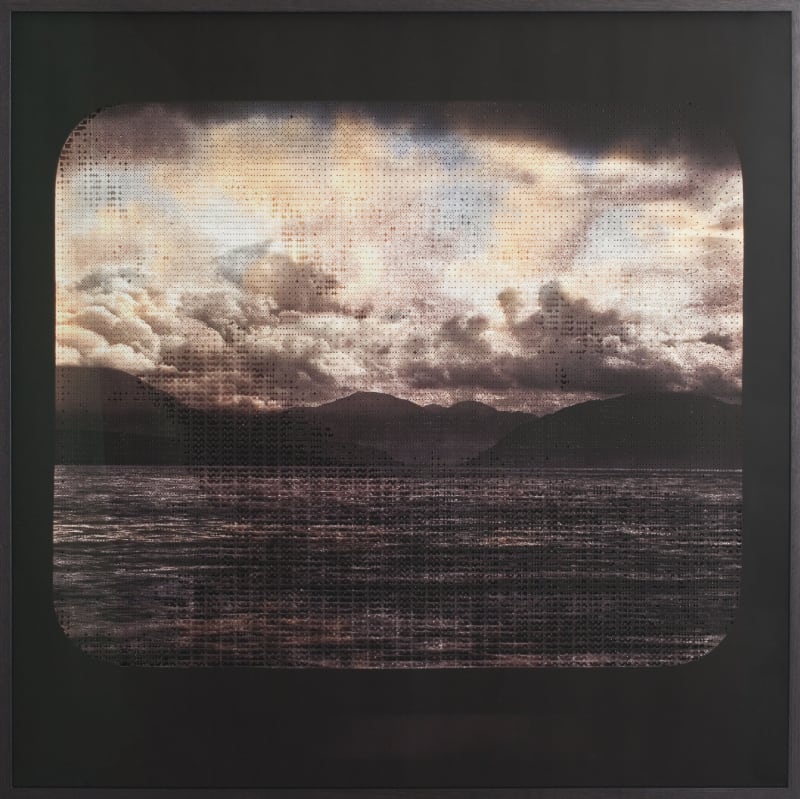Artist Talk 17th of April : Jon Sharples and artist Caroline Jane Harris on A Three-Dimensional Sky. Doors open 6:30, talk begins at 7:00 PM.
“A Three-Dimensional Sky”
CAROLINE JANE HARRIS
Private view: 27th of March, 6:30 -9pm
Crashing waves, sea spray and looming snow-topped mountains, British artist Caroline Jane Harris’ latest body of work adopts nature’s expanse as a lens through which to explore the relationship between image-making, subject and object. Extending traditional methods of photography, printmaking and drawing, as well as digital technologies, Harris creates meticulous hybrid artworks that traverse time, dimension and materiality. Central to each work, is a digital photograph that has been precisely cut-out by hand, translating immaterial image into lived experience for both artist and viewer in each iteration of Harris’ evolving applied processes. For her solo show A Three Dimensional Sky at Kristin Hjellegjerde Gallery London, she combines sourced analogue photographs in the form of century-old magic lantern slides with her own recent digital images, flattening time, space and place into an array of multi-dimensional tactile artworks.
Harris began this body of work by collecting historic slides featuring vast natural subjects that project outwards in defiance of their portable scale. She was drawn to these glass positives because “they’re both image and object, historic technologies yet timeless subjects and are like portable windows onto the world”. With the passage of time these slides have become detached from their original contexts, and gain the patina of an indistinguishable past. Harris mirrors such attributes through extensively layering and re-photographing these image-objects to create soft pictures in contrast with the exacting spaces latterly cut-through or layered on top of her prints. Within the exhibition, we are presented with various age-toned digital prints of dynamic seas, still mountains and sweeping vistas.
The artworks Crashing Waves I, II & III, manifest multiple layers of time: the moments the photographs were taken, the age of the slides, and the accumulation of hours spent cutting the prints. Harris’ manipulation of the images, which causes a visual degradation of clarity, combined with the cut-out spaces serves to expose rather than hide the underlying structures of the images’ making. ‘As the sky has no surface and is intangible, the sea has no colour itself, it only reflects what’s above or below; like the digital image is only a representation of a coded language,’ comments Harris. The final pieces present a multiplicity of perspectives within one frame, taking the viewer through the systems of horizontal and vertical planes, denying the virtual depth of the image in contract to the real depths in space.
As Harris uses one work to generate the next, she employed her guide-stencils from the Crashing Waves series in conjunction with the hybrid printmaking process of photo-etching to make Hard Copy (Crashing Waves I, II & III), capturing the negative cut-space in zinc. These pieces are neither print, photograph, nor drawing, but occupy a space between two and three dimensions. The sense of elusiveness that permeates Harris’ work can offer a commentary on our contemporary digital world. As the viewer approaches these artworks, the whole becomes increasingly fractured and distant until it is entirely dissolved, just as the selected images we are fed by the media, such as in the case of natural disasters, inevitably show us a small part of the full picture, therefore manipulating our understanding of that particular narrative. Moreover, the dissolve between figuration and abstraction functions as a reminder of our inability to ever fully view an expanse such as the sea. Whilst we might stand on the shores and know that this enormous body of water connects land around the globe, we can only ever glimpse a snapshot of it.
Demonstrating an alternative use of layering in both pre- and post-production, A Distant Presence presents us with a diptych of hand-cut digital prints against a white background. This artwork features a single photograph with dual perspectives; a bisection that mimics the horizon line within the image itself and the distant waves interlaced with a foam that encapsulates both the substance and departure of the sea, characterised in the absence of the cut-out spaces.
Despite the timelessness of the subject matter, Harris’ repurposing of photographs and processes invites us to consider the temporality and fragility of contemporary images. Whilst the breakable yet solid slides have lasted, even improved with time, digital imagery is at risk of vanishing without leaving a mark as we continually update new medias and software. This is perhaps reflected most evidently where Harris has photographed slides of mountains over a layer of tissue and re-printed these as the background layer. Veiling the prints is an ultra-thin translucent cut-out tissue paper that is traditionally used to clean camera lenses. Whilst the tissue conventionally improves visual clarity, here it softens, creating a veil of fog in front and behind the mountain. We find ourselves in a scenario where the reproducible digital print may outlast its digital counterpart, shifting importance to historical modes of production. Just as the ocean unifies different shores in time and space, Harris’ works compress past and present into one experience.


